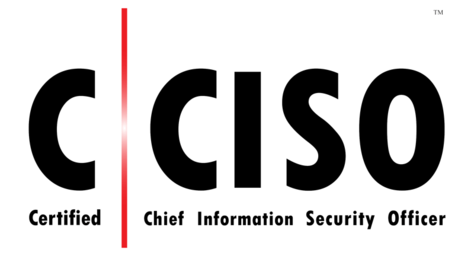C|CISO Domain Details
C|CISOs are certified in the knowledge of and experience in the following C|CISO Domains:
1. Define, Implement, Manage, and Maintain an Information Security Governance Program
- 1.1. Form of Business Organization
- 1.2. Industry
- 1.3. Organizational Maturity
2. Information Security Drivers
3. Establishing an information security management structure
- 3.1. Organizational Structure
- 3.2. Where does the CISO fit within the organizational structure
- 3.3. The Executive CISO
- 3.4. Nonexecutive CISO
4. Laws/Regulations/Standards as drivers of Organizational Policy/Standards/Procedures
5. Managing an enterprise information security compliance program
- 5.1. Security Policy
- 5.1.1. Necessity of a Security Policy
- 5.1.2. Security Policy Challenges
- 5.2. Policy Content
- 5.2.1. Types of Policies
- 5.2.2. Policy Implementation
- 5.3. Reporting Structure
- 5.4. Standards and best practices
- 5.5. Leadership and Ethics
- 5.6. EC-Council Code of Ethics
6. Introduction to Risk Management
- 3.1. Organizational Structure
- 3.2. Where does the CISO fit within the organizational structure
- 3.3. The Executive CISO
- 3.4. Nonexecutive CISO
1. Information Security Controls
- 1.1. Identifying the Organization’s Information Security Needs
- 1.1.1. Identifying the Optimum Information Security Framework
- 1.1.2. Designing Security Controls
- 1.1.3. Control Lifecycle Management
- 1.1.4. Control Classification
- 1.1.5. Control Selection and Implementation
- 1.1.6. Control Catalog
- 1.1.7. Control Maturity
- 1.1.8. Monitoring Security Controls
- 1.1.9. Remediating Control Deficiencies
- 1.1.10. Maintaining Security Controls
- 1.1.11. Reporting Controls
- 1.1.12. Information Security Service Catalog
2. Compliance Management
- 2.1. Acts, Laws, and Statutes
- 2.1.1. FISMA
- 2.2. Regulations
- 2.2.1. GDPR
- 2.3. Standards
- 2.3.1. ASD—Information Security Manual
- 2.3.2. Basel III
- 2.3.3. FFIEC
- 2.3.4. ISO 00 Family of Standards
- 2.3.5. NERC-CIP
- 2.3.6. PCI DSS
- 2.3.7. NIST Special Publications
- 2.3.8. Statement on Standards for Attestation Engagements No. 16 (SSAE 16)
3. Guidelines, Good and Best Practices
4. Audit Management
- 4.1. Audit Expectations and Outcomes
- 4.2. IS Audit Practices
- 4.2.1. ISO/IEC Audit Guidance
- 4.2.2. Internal versus External Audits
- 4.2.3. Partnering with the Audit Organization
- 4.2.4. Audit Process
- 4.2.5. General Audit Standards
- 4.2.6. Compliance-Based Audits
- 4.2.7. Risk-Based Audits
- 4.2.8. Managing and Protecting Audit Documentation
- 4.2.9. Performing an Audit
- 4.2.10. Evaluating Audit Results and Report
- 4.2.11. Remediating Audit Findings
- 4.2.12. Leverage GRC Software to Support Audits
5. Summary
1. Information Security Controls
- 1.1. Identifying the Organization’s Information Security Needs
- 1.1.1. Identifying the Optimum Information Security Framework
- 1.1.2. Designing Security Controls
- 1.1.3. Control Lifecycle Management
- 1.1.4. Control Classification
- 1.1.5. Control Selection and Implementation
- 1.1.6. Control Catalog
- 1.1.7. Control Maturity
- 1.1.8. Monitoring Security Controls
- 1.1.9. Remediating Control Deficiencies
- 1.1.10. Maintaining Security Controls
- 1.1.11. Reporting Controls
- 1.1.12. Information Security Service Catalog
2. Compliance Management
- 2.1. Acts, Laws, and Statutes
- 2.1.1. FISMA
- 2.2. Regulations
- 2.2.1. GDPR
- 2.3. Standards
- 2.3.1. ASD—Information Security Manual
- 2.3.2. Basel III
- 2.3.3. FFIEC
- 2.3.4. ISO 00 Family of Standards
- 2.3.5. NERC-CIP
- 2.3.6. PCI DSS
- 2.3.7. NIST Special Publications
- 2.3.8. Statement on Standards for Attestation Engagements No. 16 (SSAE 16)
3. Guidelines, Good and Best Practices
4. Audit Management
- 4.1. Audit Expectations and Outcomes
- 4.2. IS Audit Practices
- 4.2.1. ISO/IEC Audit Guidance
- 4.2.2. Internal versus External Audits
- 4.2.3. Partnering with the Audit Organization
- 4.2.4. Audit Process
- 4.2.5. General Audit Standards
- 4.2.6. Compliance-Based Audits
- 4.2.7. Risk-Based Audits
- 4.2.8. Managing and Protecting Audit Documentation
- 4.2.9. Performing an Audit
- 4.2.10. Evaluating Audit Results and Report
- 4.2.11. Remediating Audit Findings
- 4.2.12. Leverage GRC Software to Support Audits
5. Summary
1. Program Management
- 1.1. Defining a Security Charter, Objectives, Requirements, Stakeholders, and Strategies
- 1.1.1. Security Program Charter
- 1.1.2. Security Program Objectives
- 1.1.3. Security Program Requirements
- 1.1.4. Security Program Stakeholders
- 1.1.5. Security Program Strategy Development
- 1.2. Executing an Information Security Program
- 1.3. Defining and Developing, Managing and Monitoring the Information Security Program
- 1.3.1. Defining an Information Security Program Budget
- 1.3.2. Developing an Information Security Program Budget
- 1.3.3. Managing an Information Security Program Budget
- 1.3.4. Monitoring an Information Security Program Budget
- 1.4. Defining and Developing Information Security Program Staffing Requirements
- 1.5. Managing the People of a Security Program
- 1.5.1. Resolving Personnel and Teamwork Issues
- 1.5.2. Managing Training and Certification of Security Team Members
- 1.5.3. Clearly Defined Career Path
- 1.5.4. Designing and Implementing a User Awareness Program
- 1.6. Managing the Architecture and Roadmap of the Security Program
- 1.6.1. Information Security Program Architecture
- 1.6.2. Information Security Program Roadmap
- 1.7. Program Management and Governance
- 1.7.1. Understanding Project Management Practices
- 1.7.2. Identifying and Managing Project Stakeholders
- 1.7.3. Measuring the Effectives of Projects
- 1.8. Business Continuity Management (BCM) and Disaster Recovery Planning (DRP)
- 1.9. Data Backup and Recovery
- 1.10. Backup Strategy
- 1.11. ISO BCM Standards
- 1.11.1. Business Continuity Management (BCM)
- 1.11.2. Disaster Recovery Planning (DRP)
- 1.12. Continuity of Security Operations
- 1.12.1. Integrating the Confidentiality, Integrity and Availability (CIA) Model
- 1.13. BCM Plan Testing
- 1.14. DRP Testing
- 1.15. Contingency Planning, Operations, and Testing Programs to Mitigate Risk and Meet Service Level Agreements (SLAs)
- 1.16. Computer Incident Response
- 1.16.1. Incident Response Tools
- 1.16.2. Incident Response Management
- 1.16.3. Incident Response Communications
- 1.16.4. Post-Incident Analysis
- 1.16.5. Testing Incident Response Procedures
- 1.17. Digital Forensics
- 1.17.1. Crisis Management
- 1.17.2. Digital Forensics Life Cycle
2. Operations Management
- 2.1. Establishing and Operating a Security Operations (SecOps) Capability
- 2.2. Security Monitoring and Security Information and Event Management (SIEM)
- 2.3. Event Management
- 2.4. Incident Response Model
- 2.4.1. Developing Specific Incident Response Scenarios
- 2.5. Threat Management
- 2.6. Threat Intelligence
- 2.6.1. Information Sharing and Analysis Centers (ISAC)
- 2.7. Vulnerability Management
- 2.7.1. Vulnerability Assessments
- 2.7.2. Vulnerability Management in Practice
- 2.7.3. Penetration Testing
- 2.7.4. Security Testing Teams
- 2.7.5. Remediation
- 2.8. Threat Hunting
3. Summary
1. Access Control
- 1.1. Authentication, Authorization, and Auditing
- 1.2. Authentication
- 1.3. Authorization
- 1.4. Auditing
- 1.5. User Access Control Restrictions
- 1.6. User Access Behavior Management
- 1.7. Types of Access Control Models
- 1.8. Designing an Access Control Plan
- 1.9. Access Administration
2. Physical Security
- 2.1. Designing, Implementing, and Managing Physical Security Program
- 2.1.1. Physical Risk Assessment
- 2.2. Physical Location Considerations
- 2.3. Obstacles and Prevention
- 2.4. Secure Facility Design
- 2.4.1. Security Operations Center
- 2.4.2. Sensitive Compartmented Information Facility
- 2.4.3. Digital Forensics Lab
- 2.4.4. Datacenter
- 2.5. Preparing for Physical Security Audits
[/su_list]
3. Network Security
- 3.1. Network Security Assessments and Planning
- 3.2. Network Security Architecture Challenges
- 3.3. Network Security Design
- 3.4. Network Standards, Protocols, and Controls
- 3.4.1. Network Security Standards
- 3.4.2. Protocols
4. Certified Chief
- 4.1.1. Network Security Controls
- 4.2. Wireless (Wi-Fi) Security
- 4.2.1. Wireless Risks
- 4.2.2. Wireless Controls
- 4.3. Voice over IP Security
5. Endpoint Protection
- 5.1. Endpoint Threats
- 5.2. Endpoint Vulnerabilities
- 5.3. End User Security Awareness
- 5.4. Endpoint Device Hardening
- 5.5. Endpoint Device Logging
- 5.6. Mobile Device Security
- 5.6.1. Mobile Device Risks
- 5.6.2. Mobile Device Security Controls
- 5.7. Internet of Things Security (IoT)
- 5.7.1. Protecting IoT Devices
6. Application Security
- 6.1. Secure SDLC Model
- 6.2. Separation of Development, Test, and Production Environments
- 6.3. Application Security Testing Approaches
- 6.4. DevSecOps
- 6.5. Waterfall Methodology and Security
- 6.6. Agile Methodology and Security
- 6.7. Other Application Development Approaches
- 6.8. Application Hardening
- 6.9. Application Security Technologies
- 6.10. Version Control and Patch Management
- 6.11. Database Security
- 6.12. Database Hardening
- 6.13. Secure Coding Practices
7. Encryption Technologies
- 7.1. Encryption and Decryption
- 7.2. Cryptosystems
- 7.2.1. Blockchain
- 7.2.2. Digital Signatures and Certificates
- 7.2.3. PKI
- 7.2.4. Key Management
- 7.3. Hashing
- 7.4. Encryption Algorithms
- 7.5. Encryption Strategy Development
- 7.5.1. Determining Critical Data Location and Type
- 7.5.2. Deciding What to Encrypt
- 7.5.3. Determining Encryption Requirements
- 7.5.4. Selecting, Integrating, and Managing Encryption Technologies
8. Virtualization Security
- 8.1. Virtualization Overview
- 8.2. Virtualization Risks
- 8.3. Virtualization Security Concerns
- 8.4. Virtualization Security Controls
- 8.5. Virtualization Security Reference Model
9. Cloud Computing Security
- 9.1. Overview of Cloud Computing
- 9.2. Security and Resiliency Cloud Services
- 9.3. Cloud Security Concerns
- 9.4. Cloud Security Controls
- 9.5. Cloud Computing Protection Considerations
10. Transformative Technologies
- 10.1. Artificial Intelligence
- 10.2. Augmented Reality
- 10.3. Autonomous SOC
- 10.4. Dynamic Deception
- 10.5. Software-Defined Cybersecurity
11. Summary
1. Strategic Planning
- 1.1. Understanding the Organization
- 1.1.1. Understanding the Business Structure
- 1.1.2. Determining and Aligning Business and Information Security Goals
- 1.1.3. Identifying Key Sponsors, Stakeholders, and Influencers
- 1.1.4. Understanding Organizational Financials
- 1.2. Creating an Information Security Strategic Plan
- 1.2.1. Strategic Planning Basics
- 1.2.2. Alignment to Organizational Strategy and Goals
- 1.2.3. Defining Tactical Short, Medium, and Long-Term Information Security Goals
- 1.2.4. Information Security Strategy Communication
- 1.2.5. Creating a Culture of Security
2. Designing, Developing, and Maintaining an Enterprise Information Security Program
- 2.1. Ensuring a Sound Program Foundation
- 2.2. Architectural Views
- 2.3. Creating Measurements and Metrics
- 2.4. Balanced Scorecard
- 2.5. Continuous Monitoring and Reporting Outcomes
- 2.6. Continuous Improvement
- 2.7. Information Technology Infrastructure Library (ITIL) Continual Service Improvement (CSI)
3. Understanding the Enterprise Architecture (EA)
- 3.1. EA Types
- 3.1.1. The Zachman Framework
- 3.1.2. The Open Group Architecture Framework (TOGAF)
- 3.1.3. Sherwood Applied Business Security Architecture (SABSA)
- 3.1.4. Federal Enterprise Architecture Framework (FEAF)
4. Finance
- 4.1. Understanding Security Program Funding
- 4.2. Analyzing, Forecasting, and Developing a Security Budget
- 4.2.1. Resource Requirements
- 4.2.2. Define Financial Metrics
- 4.2.3. Technology Refresh
- 4.2.4. New Project Funding
- 4.2.5. Contingency Funding
- 4.3. Managing the information Security Budget
- 4.3.1. Obtain Financial Resources
- 4.3.2. Allocate Financial Resources
- 4.3.3. Monitor and Oversight of Information Security Budget
- 4.3.4. Report Metrics to Sponsors and Stakeholders
- 4.3.5. Balancing the Information Security Budget
5. Procurement
- 5.1. Procurement Program Terms and Concepts
- 5.1.1. Statement of Objectives (SOO)
- 5.1.2. Statement of Work (SOW)
- 5.1.3. Total Cost of Ownership (TCO)
- 5.1.4. Request for Information (RFI)
- 5.1.5. Request for Proposal (RFP)
- 5.1.6. Master Service Agreement (MSA)
- 5.1.7. Service Level Agreement (SLA)
- 5.1.8. Terms and Conditions (T&C)
- 5.2. Understanding the Organization’s Procurement Program
- 5.2.1. Internal Policies, Processes, and Requirements
- 5.2.2. External or Regulatory Requirements
- 5.2.3. Local Versus Global Requirements
- 5.3. Procurement Risk Management
- 5.3.1. Standard Contract Language
6. Vendor Management
- 6.1. Understanding the Organization’s Acquisition Policies and Procedures
- 6.1.1. Procurement Life cycle
- 6.2. Applying Cost-Benefit Analysis (CBA) During the Procurement Process5
- 6.3. Vendor Management Policies
- 6.4. Contract Administration Policies
- 6.4.1. Service and Contract Delivery Metrics
- 6.4.2. Contract Delivery Reporting
- 6.4.3. Change Requests
- 6.4.4. Contract Renewal
- 6.4.5. Contract Closure
- 6.5. Delivery Assurance
- 6.5.1. Validation of Meeting Contractual Requirements
- 6.5.2. Formal Delivery Audits
- 6.5.3. Periodic Random Delivery Audits
- 6.5.4. Third-Party Attestation Services (TPRM)
7. Summary

